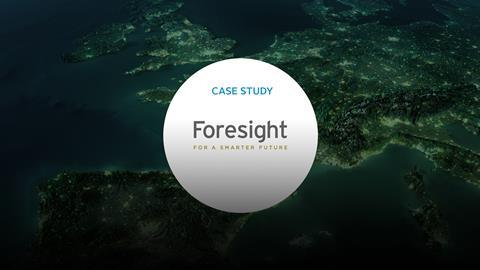| ORGANISATION DETAILS | |
|---|---|
| Name | Foresight Group |
| Signatory type | Investment manager |
| Region of operation | UK, Europe and Australia |
| Assets under management | c. £6.5bn |
| COVERED IN THIS CASE STUDY | |
|---|---|
| Name of fund | Foresight Energy Infrastructure Partners (FEIP) |
| Sector | Renewables |
| Asset class | Infrastructure (with an energy transition focus) |
| Geography | Europe |
| Environmental objective | Mitigation |
| Economic activity | Production of electricity from wind power |
Foresight believes the EU taxonomy will provide greater transparency on the sustainability credentials of renewable energy infrastructure assets in response to accelerating investor interest and appetite for sustainable and ESG investment opportunities. Therefore, we attach significant value to having the taxonomy compliance of our assets validated by an independent third party and ran a competitive tender process to identify the most suitable group to complete the work. This will afford investors additional assurance that projects are making a genuine contribution to global sustainability targets, thus helping them evade greenwashing and ensuring their money is channelled towards investments that contribute significantly to global sustainability. We intend to validate all assets within the Foresight Energy Infrastructure Partners (FEIP) fund in order to demonstrate overall fund compliance with the taxonomy.
Taxonomy implementation
Principles, criteria, thresholds
The third party used a bespoke validation protocol to ensure transparency in the assessment process. The protocol was based on the specific criteria used to assess production of electricity from wind power against the six environmental objectives set out in the taxonomy. The protocol stipulated the criteria, the evidence used, any areas requiring clarification and the final validation results. The purpose of the protocol was to detail which criteria were assessed as part of the validation engagement, and to provide a transparent, documented process of how they were assessed and validated.
Do no significant harm assessment
Having met one of the taxonomy’s six environmental objectives, compliance with the do no significant harm (DNSH) criteria was done so in the context of ensuring there was no detriment to the other five environmental objectives.
When applying this concept to climate change adaptation, the third party required us to demonstrate that the project integrated both physical and non-physical measures aimed at reducing all material risks identified through a risk assessment. The risk assessment examined current weather variability and future climate change uncertainty, carrying out a robust analysis of available climate data and projections across a range of future scenarios, consistent with the expected lifetime of the activity. Further, we had to confirm that the project did not adversely affect others’ adaptation efforts, either by exacerbating climate risks or hampering adaptation elsewhere. We also had to demonstrate consistency with sectoral, regional and/or national adaptation efforts.
Social safeguards assessment
As the taxonomy sets out the minimum social safeguards the project should meet during its operational phase, the third party assessed the extent to which the developer complied with the International Labour Organisation’s (ILO) conventions. The third party evaluated the developer’s employment and sustainability policies and objectives - mainly focusing on employee well-being, gender equality, diversity and human rights - by reviewing staffing arrangements and examining annual sustainability reports in terms of reporting and transparency.
Turnover/capex/opex alignment
As this assessment was conducted on just one asset, the proportion of taxonomy-aligned turnover/capex/opex was not applicable. The external validation concluded that the project as a whole met all stipulated criteria, as defined by the taxonomy.
To demonstrate overall fund compliance with the taxonomy, we intend to validate externally all FEIP fund assets in the same way.
Alignment results
Based on the EU taxonomy for Sustainable Activities, we defined the scope of the validation process as an independent and objective review of a specific wind project showing to what extent it conformed to the criteria stipulated in the section on Production of Electricity from Wind Power.
The review consisted of three distinct phases based on third party internal validation engagement procedures. First, they conducted a desk-based review of project documentation provided by Foresight Group LLP, the technology provider and the technical consultants who conducted due diligence on the project. Then, they clarified and resolved areas of uncertainty, before producing a validation report and opinion statement.
They conducted the desk-based review against the criteria set out in the EU Taxonomy for Sustainable Activities Technical Report, dated June 2019, Section 22.3 – Production of Electricity from Wind Power. Their validation statement reads as follows:
“Based on this validation engagement, it is our opinion that the wind project is compliant with all relevant criteria for the Production of Electricity from Wind Power as defined in the EU Taxonomy for Sustainable Activities.”
Challenges and solutions
| NO. | CHALLENGE | SOLUTION |
|---|---|---|
| 1 | The internal review may have led to overly flexible interpretations of the stipulated criteria. Indeed, misinterpretation and poor application may lead to accusations of greenwashing. | To legitimise conclusions, Foresight used third-party validation. |
| 2 | Ensuring the participation of project partners in third-party investigations. | It was essential to demonstrate the utility of the taxonomy to project partners and explain the main benefits of carrying out a project level validation, namely reputation enhancement and evidence of leading ESG and sustainability management. |
Recommendations
As the report details criteria for a wide range of economic activities it is a somewhat voluminous document. In terms of Infrastructure, adopting an asset-by-asset approach facilitates companies in focusing on a specific set of criteria, essentially turning a long and complex text into a useful and practical guide. Seen in this way, the guide is a step-by-step approach to verifying an asset’s taxonomy compliance, enabling widespread implementation across a portfolio of assets.












